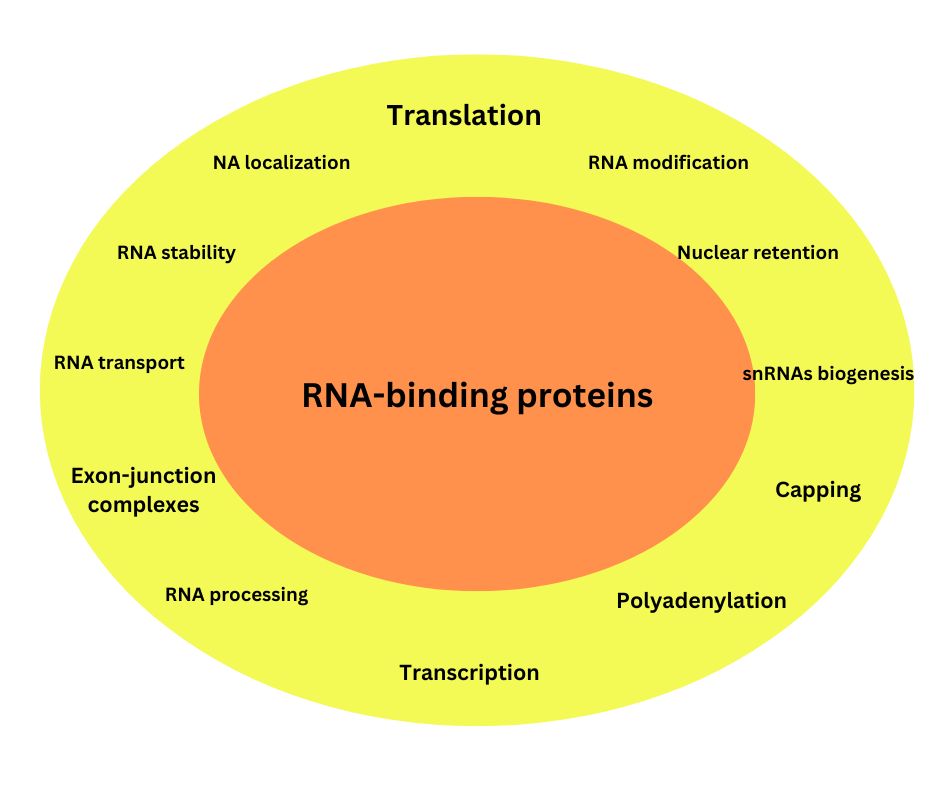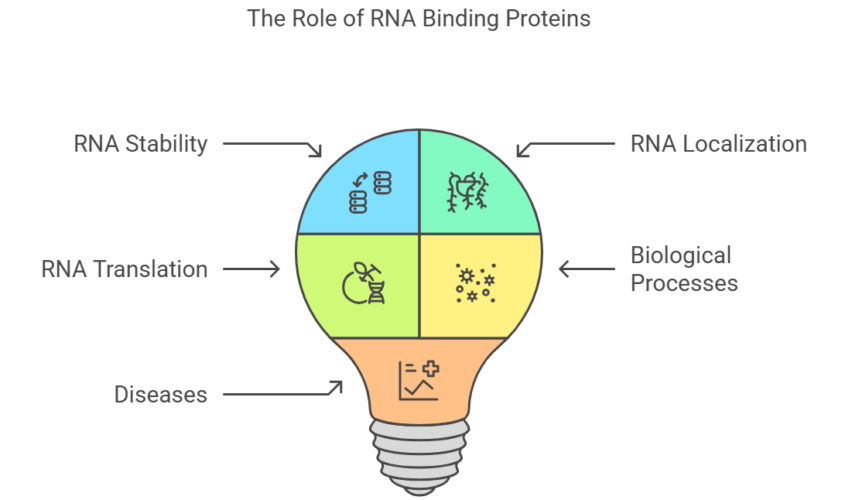RNA Binding Proteins (RBPs) are important components in the cell, playing a crucial role in how RNA functions within the body. These proteins interact directly with RNA to control stability, translation, and processing. As our understanding of proteins grows, researchers are beginning to realise their potential in developing more effective treatments for diseases like cancer, neurological disorders, and genetic conditions. In 2025, RNA-binding proteins are expected to profoundly influence medical treatments, providing new opportunities for targeted therapies.
Let’s explore RNA-binding proteins, their role in gene expression, and how they could contribute to improved treatments in 2025.
What Are RNA-Binding Proteins?

RNA-binding proteins bind to RNA molecules and regulate their function. These proteins involve many critical cellular processes, including RNA splicing, transport, stability, and translation. RNA interacts with other molecules to control how genes are expressed and how cells respond to various signals.
These are involved in both normal cell functions and in disease states. In diseases like cancer or neurodegenerative disorders, changes in the function of these proteins can cause problems in gene expression, leading to improper protein production and disease.
Penn RNA Core: Advancing RNA Research
The Penn RNA Core is a cutting-edge research facility dedicated to the exploration of RNA biology. Situated at the prestigious University of Pennsylvania, this core provides a wide range of valuable resources and state-of-the-art technologies for RNA sequencing and analysis. Researchers at the RNA Core focus on the intricate roles of RNA and RNA-binding proteins, delving into their complex functions within the cell.
Through this detailed exploration, scientists are gaining crucial insights into how RNA operates and how disturbances in RNA processes can lead to various diseases. This understanding is not only pivotal for advancing basic biological knowledge but also has significant implications for the development of novel therapeutic strategies.
Single-Cell RNA-Seq in San Francisco
Single-cell RNA sequencing (scrna-seq) is a powerful technology that allows scientists to test the gene expression of individual cells. This method has revolutionised the study of RNA by providing detailed insights into how genes are expressed in different cell types within a tissue.
Conferences and research conducted in places like San Francisco have been key in advancing this technology. Single-cell RNA-seq provides an in-depth look at how cells respond to different conditions, which is critical for understanding diseases and developing targeted therapies.
Amino Acid Sequence for UGG RNA
The RNA sequence UGG is a codon, a set of three RNA bases that corresponds to an amino acid in protein synthesis. In this case, UGG codes for the amino acid tryptophan. During translation, RNA is decoded in sets of three bases, known as codons, each of which specifies a particular amino acid.

RNA Binding Proteins and the Future of Treatments
RNA-binding proteins are essential for regulating RNA and gene expression. Their influence on RNA processing, stability, and translation makes them important targets in medical research. As we deepen our understanding of RNA-binding proteins, we can expect to see more effective and targeted treatments for diseases in 2025.
In the coming years, RNA-based treatments will likely become a central focus in the fight against many diseases, offering new hope for patients around the world. Protein discoveries will play a pivotal role in shaping the future of medicine, providing hope for more effective and personalised treatment options for patients around the world.
Learn: Vegetarian Soups for Blood Sugar
How Is RNA Created?
RNA is synthesised through a process called transcription, during which an enzyme known as RNA polymerase utilises one strand of DNA as a template to produce a complementary RNA molecule.
Are DNA and RNA Affected by Antibiotics?
Antibiotics can impact both DNA and RNA synthesis in bacteria. Some antibiotics specifically inhibit bacterial RNA polymerase, which blocks RNA transcription, while others disrupt DNA replication by targeting enzymes such as topoisomerases.
Is RNA Short-Lived?
Most RNA molecules, especially mRNA, are short-lived compared to DNA. Many are degraded within minutes, with some studies indicating an average lifespan of around two minutes for many RNA types.
Can RNA Function Without DNA?
Most RNA molecules, especially mRNA, are short-lived compared to DNA. Many are degraded within minutes, with some studies indicating an average lifespan of around two minutes for many RNA types.
Yes, RNA can function independently of DNA, as demonstrated by the RNA world hypothesis and the presence of RNA viruses. According to Khan Academy, RNA can store genetic information, replicate, and also act as a catalyst for chemical reactions, similar to proteins.




[…] Click this related article… […]
[…] Click this related article… […]
There may be noticeably a bundle to learn about this. I assume you made certain nice factors in options also.
Only wanna remark on few general things, The website style is perfect, the written content is rattling great : D.
Anyway Thanks for your comment
Lovely just what I was looking for.Thanks to the author for taking his time on this one.
Hey! I know this is kinda off topic nevertheless I’d figured I’d ask. Would you be interested in exchanging links or maybe guest writing a blog article or vice-versa? My blog goes over a lot of the same subjects as yours and I think we could greatly benefit from each other. If you are interested feel free to send me an e-mail. I look forward to hearing from you! Awesome blog by the way!
I have been browsing on-line more than three hours today, but I never discovered any attention-grabbing article like yours. It?¦s lovely worth enough for me. Personally, if all web owners and bloggers made good content material as you did, the net can be a lot more useful than ever before.
Thank you for sharing excellent informations. Your website is so cool. I am impressed by the details that you¦ve on this site. It reveals how nicely you perceive this subject. Bookmarked this website page, will come back for extra articles. You, my pal, ROCK! I found just the info I already searched all over the place and just could not come across. What a perfect web site.
I simply needed to say thanks yet again. I am not sure the things that I could possibly have created in the absence of the entire aspects shared by you concerning that situation. Certainly was a daunting problem for me personally, nevertheless being able to view the well-written strategy you resolved the issue forced me to weep with happiness. I’m just happier for this support and as well , hope that you are aware of an amazing job you are always undertaking training most people thru your web site. I know that you haven’t encountered any of us.
You have observed very interesting points! ps decent web site. “Great opportunities to help others seldom come, but small ones surround us every day.” by Sally Koch.
Nice blog right here! Also your site quite a bit up very fast! What web host are you using? Can I get your associate link on your host? I want my site loaded up as quickly as yours lol
Excellent web site. Plenty of useful info here. I’m sending it to several friends ans also sharing in delicious. And certainly, thanks for your effort!
Great work! This is the type of information that should be shared around the internet. Shame on Google for not positioning this post higher! Come on over and visit my web site . Thanks =)
fantastic post, very informative. I wonder why the other experts of this sector don’t notice this. You must continue your writing. I am sure, you have a huge readers’ base already!
Rattling wonderful information can be found on blog. “Life without a friend is death without a witness.” by Eugene Benge.
obviously like your web site but you have to check the spelling on several of your posts. Many of them are rife with spelling issues and I find it very bothersome to tell the truth nevertheless I will definitely come back again.
Great blog! I am loving it!! Will be back later to read some more. I am taking your feeds also